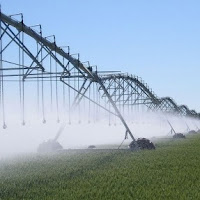Tuesday, November 13, 2012
Lower levels of arsenic in rice
Tuesday, June 12, 2012
Electric pivots versus hydrostatic systems

Center pivot systems were originally designed to operate on square fields. With the introduction of electric drive machines, center pivots started to be used on many field shapes.
T-L Irrigation manufactures hydrostatic Pivots, (the machine is powered by water propelling the pivot around the field).
The other manufacturers' equipment is powered by 480 volt electricity. The propelling motors and other equipment start and move forward when told to do so by sensors, not in a continuous motion.
Center-Pivot irrigation: benefits to the crop
The sprinkler heads are positioned along its length. There are many different nozzle configurations available. Big guns can be placed at the end of the pivot overhang to allow the water system to reach even the farthest edges of a field.
Typically pivots work on flat fields, but even fields can benefit from this type of irrigation system. Many farmers are finding that center pivot irrigation satisfies many of their crops' consistent water needs.
Friday, January 27, 2012
Pivot irrigation in Georgia
 In Southwest Georgia there are more than 6,000 center pivots used to water peanuts, cotton and corn. Farmers have control over how much water the irrigation nozzles spray as they pass over fields. Small fields can vary in topography and soil types, with some places wetter or drier than other places in the same field.
In Southwest Georgia there are more than 6,000 center pivots used to water peanuts, cotton and corn. Farmers have control over how much water the irrigation nozzles spray as they pass over fields. Small fields can vary in topography and soil types, with some places wetter or drier than other places in the same field.VRI technology
Growers want to irrigate more precisely, but don't have the time or level with higher-tech gadgets. The more time-consuming technology steps have been eliminated to make the system easier for farmers to use.
Instead of having to create computer maps of fields, this system has a simple "push-button" feature. A farmer can start the center pivot over a field. When it gets to a location he doesn't want to apply water, the farmer pushes the button to train the system not to water that area. Once the system passes this area, he pushes the button again to resume watering only the crop. This can be done in as many as 8 locations in the same field.
The water efficiency of VRI has been tested on farms in Georgia and found it can reduce the water use in a field by as much as 15% annually without sacrificing crop yield.

